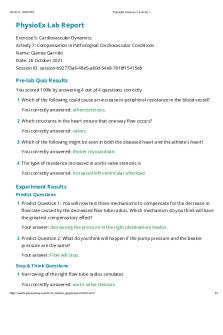Physio Ex Exercise 5 Activity 5 PDF

| Title | Physio Ex Exercise 5 Activity 5 |
|---|---|
| Author | Kyleigh Hankton |
| Course | Human Anatomy Laboratory |
| Institution | Alcorn State University |
| Pages | 3 |
| File Size | 94.2 KB |
| File Type | |
| Total Downloads | 34 |
| Total Views | 145 |
Summary
The work for this class...
Description
2/5/2021
PhysioEx Exercise 5 Activity 5
PhysioEx Lab Report Exercise 5: Cardiovascular Dynamics Activity 5: Studying the Effect of Blood Vessel Radius on Pump Activity Name: Kyleigh Hankton Date: 5 February 2021 Session ID: session-98e658a2-d7e9-cee8-0e22-5e08ea7c14c0
Pre-lab Quiz Results You scored 100% by answering 5 out of 5 questions correctly. 1 The heart is resting during You correctly answered: ventricular diastole. 2 The right side of the heart pumps blood You correctly answered: to the lungs. 3 The layer of the blood vessel that is stimulated by the autonomic nervous system is You correctly answered: smooth muscle. 4 In the experiment, the pump simulates You correctly answered: the left ventricle of the heart. 5 If the right beaker simulates the flow of blood to the systemic circuit of the body, what do the right valve and flow tube represent? You correctly answered: aortic valve and aorta.
Experiment Results Predict Question 1 Predict Question: If you increase the flow tube radius, what will happen to the pump rate to maintain constant pressure? Your answer: The pump rate will increase. Stop & Think Questions 1 When the piston of the pump reaches its lowest point, the volume remaining in the pump is the i https://media.pearsoncmg.com/bc/bc_0media_ap/physioex/10/ex5/act5/
1/3
2/5/2021
PhysioEx Exercise 5 Activity 5
You correctly answered: end systolic volume. 2 If you increase the right flow tube radius, what will happen to resistance and flow rate? You correctly answered: Flow rate will increase and resistance will decrease. 3 If the left flow tube represents the pulmonary veins, what does the left source beaker represent? You correctly answered: blood coming from the lungs. Experiment Data Flow (ml/min)
Rad. L (mm)
Rad. R (mm)
Str. V (ml)
Rate (strokes /min)
Press. L (mmHg)
Press. Dif. R (mm Hg)
6607.2
3.5
3.0
70
94.4
40
40
9423.9
3.5
3.5
70
134.6
40
40
11882.5
3.5
4.0
70
169.8
40
40
13798.3
3.5
4.5
70
197.1
40
40
15198.7
3.5
5.0
70
217.1
40
40
Post-lab Quiz Results You scored 100% by answering 5 out of 5 questions correctly. 1 The pump piston in the simulation is up during You correctly answered: diastole. 2 The pump in the simulation represents the https://media.pearsoncmg.com/bc/bc_0media_ap/physioex/10/ex5/act5/
i 2/3
2/5/2021
PhysioEx Exercise 5 Activity 5
You correctly answered: left ventricle. 3 The amount of blood flowing into the destination beaker (right beaker) with a single pump is called the You correctly answered: stroke volume. 4 In this experiment, the increase in right flow tube radius resulted in You correctly answered: an increase in flow rate, which increased the pump rate. 5 Which chamber should be present in the flow pattern of the experiment, given that the vessels and valves surrounding it are present (the chamber was omitted from the experiment for simplicity)? You correctly answered: left atrium.
Review Sheet Results 1 Explain the effect of increasing the right flow tube radius on the flow rate, resistance, and pump rate. Your answer: Both the resistance and pump rate increase when the blood vessel radius increases. 2 Describe what the left and right beakers in the experiment correspond to in the human heart. Your answer: The left beaker is the left ventricle, while the right beaker corresponds to the aortic valve and aorta. 3 Briefly describe how the human heart could compensate for flow rate changes to maintain blood pressure. Your answer: The human heart either reduces or increases the pump rate in order to maintain blood pressure.
i https://media.pearsoncmg.com/bc/bc_0media_ap/physioex/10/ex5/act5/
3/3...
Similar Free PDFs

Physio Ex Exercise 5 Activity 5
- 3 Pages

Physio Ex Exercise 5 Activity 5
- 2 Pages

Physio Ex Exercise 5 Activity 5
- 3 Pages

Physio Ex Exercise 5 Activity 5
- 3 Pages

Physio Ex Exercise 5 Activity 7
- 3 Pages

Physio Ex Exercise 5 Activity 4
- 3 Pages

Physio Ex Exercise 1 Activity 5
- 3 Pages

Physio Ex Exercise 3 Activity 5
- 7 Pages

Physio Ex Exercise 5 Activity 6
- 3 Pages

Physio Ex Exercise 5 Activity 3
- 3 Pages

Physio Ex Exercise 9 Activity 5
- 3 Pages

Physio Ex Exercise 5 Activity 3
- 3 Pages

Physio Ex Exercise 6 Activity 5
- 4 Pages

Physio Ex Exercise 5 Activity 6
- 3 Pages

Physio Ex Exercise 5 Activity 6
- 3 Pages

Physio Ex Exercise 9 Activity 5
- 3 Pages
Popular Institutions
- Tinajero National High School - Annex
- Politeknik Caltex Riau
- Yokohama City University
- SGT University
- University of Al-Qadisiyah
- Divine Word College of Vigan
- Techniek College Rotterdam
- Universidade de Santiago
- Universiti Teknologi MARA Cawangan Johor Kampus Pasir Gudang
- Poltekkes Kemenkes Yogyakarta
- Baguio City National High School
- Colegio san marcos
- preparatoria uno
- Centro de Bachillerato Tecnológico Industrial y de Servicios No. 107
- Dalian Maritime University
- Quang Trung Secondary School
- Colegio Tecnológico en Informática
- Corporación Regional de Educación Superior
- Grupo CEDVA
- Dar Al Uloom University
- Centro de Estudios Preuniversitarios de la Universidad Nacional de Ingeniería
- 上智大学
- Aakash International School, Nuna Majara
- San Felipe Neri Catholic School
- Kang Chiao International School - New Taipei City
- Misamis Occidental National High School
- Institución Educativa Escuela Normal Juan Ladrilleros
- Kolehiyo ng Pantukan
- Batanes State College
- Instituto Continental
- Sekolah Menengah Kejuruan Kesehatan Kaltara (Tarakan)
- Colegio de La Inmaculada Concepcion - Cebu